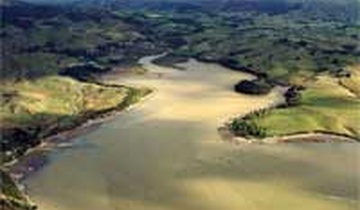"Human influence on the climate system is clear".
This is one of the key conclusions announced today by Working Group 1 of the Intergovernmental Panel on Climate Change, in the summary of its contribution to the IPCC's Fifth Assessment.
The report confirms and strengthens many of the findings of the Fourth Assessment completed in 2007, regarding observed changes in climate and their causes. It concludes that continued emissions of greenhouse gases will cause further warming and changes in all components of the climate system. It provides projections for future changes in climate, sea level, and ocean properties, for a range of possible scenarios of greenhouse gas emissions from human activities.
The report has been prepared by a team of leading climate scientists from around the world, who have assessed research from thousands of scientific papers.
Three of the report's lead authors are from New Zealand: Professor David Frame, Professor Tim Naish, and Associate Professor James Renwick, all of Victoria University. NIWA Chief Scientist Climate Dr David Wratt is a Vice Chair of IPCC Working Group 1.
The report confirms that warming of the climate system is unequivocal, pointing particularly to observed changes since 1950 including warming of the atmosphere and oceans, decreases in the amount of snow and ice, and rise in sea level.
The report documents a continuing increase in the concentration of greenhouse gases in the atmosphere. Concentrations of carbon dioxide are now at levels unprecedented in at least the last 800,000 years, primarily due to burning of fossil fuels and secondarily from land use changes. The ocean has absorbed about 30% of the anthropogenic carbon dioxide, causing ocean acidification.
A plenary session in Stockholm this week approved the Summary for Policymakers of the IPCC Working Group 1 Report, which deals with the physical science basis of climate change. The report was reviewed by 1089 experts and 38 governments in a multi-stage process.
Dr Wratt has been in Stockholm at the plenary. He says the report builds on findings from previous IPCC assessments, drawing on a huge amount of published research.
"This report provides policymakers and the public with a very thorough assessment of the current state of knowledge. It describes the changes which have been observed around the globe, examines their causes, and outlines expected climate changes under four future greenhouse 'concentration pathway' scenarios, which between them span a broad range of possible future greenhouse gas emissions.
"These scenarios provide policy-relevant information for governments," Dr Wratt says.
"Under the highest emission scenario, there is at least a 50% chance that the global surface temperature increase by the end of this century will exceed 4°C above pre-industrial times. But under the lowest scenario, global surface temperature increase is unlikely (less than 33% chance) to exceed 2°C.
"This lowest-emissions scenario includes substantial reductions in anthropogenic greenhouse gas emissions as the century progresses and possibly sustained removal of carbon dioxide from the atmosphere by the end of the 21st Century. We'll now be doing further work at NIWA on the way New Zealand climate is likely to change under these various scenarios".
The report says for the highest emission scenario, global sea level in 2100 is likely to be between 52cm and 98cm higher than 1986 - 2005 values. Sea level rise by the late 21st Century under the lowest-emissions scenario is likely to be in the range of 26cm to 55 cm.
Compared to the time of the previous IPCC report (2007), more detailed and longer climate observations are available, and climate models have improved. Human influences have been identified on more parts of the climate system including warming of the atmosphere and ocean, changes in the global water cycle, reductions in snow and ice, global mean sea level rise, and changes in some climate extremes. It is extremely likely that human influence has been the dominant cause of the observed warming since the mid-20th Century.
"Each of the last three decades has been warmer at the earth's surface than any preceding decade since 1850. In the Northern Hemisphere, 1983-2012 was likely the warmest 30-year period of the last 1400 years."
The report also says it is virtually certain that as global mean temperatures increase, there will be more frequent hot temperature extremes over most land areas, and fewer cold extremes. It is very likely heat waves will occur more often and last longer.
Depending on the scenario, about 15% to 40% of emitted carbon dioxide will remain in the atmosphere longer than 1000 years. Surface temperatures will remain approximately constant at elevated levels for many centuries after a complete cessation of anthropogenic carbon dioxide emissions. It is virtually certain that global mean sea level rise will continue beyond 2100, with sea level rise due to thermal expansion to continue for many centuries.
The IPCC is working on two further assessment reports. The Working Group 2 report addressing vulnerability, impacts and adaptation, will be finalised in March 2014, and the Working Group 3 report on mitigation of climate change in April 2014.
Other key findings:
- The globally averaged combined land and ocean surface temperature data show a warming of 0.85 [0.65 to 1.06] over 1880 – 2012. Almost the entire globe has experienced surface warming over this period.
- Temperature trends based on short records are very sensitive to beginning and end dates, due to natural variability. They do not in general reflect long-term climate trends. For example, the trend in global surface temperatures over the past 15 years (1998-2012), which begin with a strong El Nino year, is smaller than the warming trend calculated for 1951-2012. Natural variability during the last 15 years may have included redistribution of heat within the ocean, slowing the rate of surface warming.
- Over the last two decades the Greenland and Antarctic ice sheets have been losing mass, glaciers have continued to shrink almost worldwide, and Arctic sea ice and Northern hemisphere spring snow cover have continued to decrease in extent.
- The annual mean Arctic sea ice extent decreased over the period 1979-2012. There is medium confidence that that summer sea ice retreat and sea surface temperatures in the Arctic are anomalous in at least the last 1450 years. The Antarctic sea ice extent showed a small increase overall between 1979 and 2012, increasing in some regions and decreasing in others.
- Global mean sea level rose by 19cm [17 to 21 cm] over the period 1901-2010.
- The concentration of carbon dioxide in the atmosphere has increased to levels unprecedented in at least the last 800,000 years. This has been caused primarily by burning fossil fuels and secondarily by land use change. The ocean has absorbed about 30% of the anthropogenic carbon dioxide, causing ocean acidification.
- The atmospheric concentrations of the greenhouse gases carbon dioxide, methane and nitrous oxide have all increased since 1750 due to human activity. In 2011 the concentrations of these gases exceed pre-industrial levels by about 40%, 50% and 20% respectively.
- Four possible future greenhouse gas concentration scenarios are considered in detail in the report, ranging from one in which
emissions are reduced substantially as the century progresses, to one with continuing high emission rates. Global surface temperature change for the end of the 21st Century is projected to likely exceed 1.5°C relative to pre-industrial in all but the lowest scenario, and likely to exceed 2°C for the two highest scenarios. - It is virtually certain that as global mean temperatures increase there will be more frequent hot, and fewer cold, temperature extremes over most land areas, and very likely more heat waves that last longer.
- There is very high confidence that the Arctic region will warm more rapidly than the global mean, and mean warming over land will be larger than over the ocean.
- As the 21st Century progresses, the contrast in precipitation (rain and snowfall) between wet and dry regions and between wet and dry seasons will increase, although there may be regional exceptions.
- Extreme precipitation events over most of the mid-latitude land masses and over wet tropical regions will very likely become
more intense and more frequent in a warmer world. - The global ocean will continue to warm during the 21st Century. Heat will penetrate from the surface to the deep ocean and affect ocean circulation.
- It is very likely that the Arctic sea ice cover will continue to shrink and thin and that Northern Hemisphere spring snow cover will decrease during the 21st Century as global temperature rises. Global glacier volume will further decrease.
- Global mean sea level will continue to rise during the 21st century. Confidence in projections of global sea level rise has
increased since the Fourth Assessment (2007). - For the four main future greenhouse gas concentration scenarios considered in the report, the global mean sea level rises for
2081-2100 relative to 1986-2005 are likely to be in the ranges 26-55cm; 32-63 cm, 33 to 63cm and 45-82cm respectively. - Based on current understanding, only the collapse of marine-based sectors of the Antarctic Ice Sheet, if initiated, could cause
sea-level to rise substantially above these "likely" ranges during the 21st Century. However there is medium confidence that this additional contribution would not exceed several tenths of a metre of sea level rise during the 21st Century. - Further uptake of carbon dioxide by the ocean will increase ocean acidification.
- Many aspects of climate change will persist for many centuries, even if emissions of carbon dioxide are stopped. This represents a substantial multi-century climate change commitment created by past, present and future emissions of carbon dioxide.
View the full report at www.climatechange2013.org








